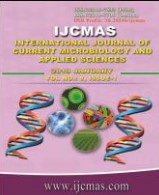


 National Academy of Agricultural Sciences (NAAS)
National Academy of Agricultural Sciences (NAAS)

|
PRINT ISSN : 2319-7692
Online ISSN : 2319-7706 Issues : 12 per year Publisher : Excellent Publishers Email : editorijcmas@gmail.com / submit@ijcmas.com Editor-in-chief: Dr.M.Prakash Index Copernicus ICV 2018: 95.39 NAAS RATING 2020: 5.38 |
Ralstonia solanacearum is a soil inhabiting devastating bacterium causing wilt disease in several important agricultural crops. It has an extremely wide host range and ranked as the 2nd destructive and economically important plant pathogenic bacterium of the world. Although several substances like the antibiotics are used in wide scale for its management. However due to numerous limitations such as the emergence of antibiotic resistant bacterial strains, horizontal gene transfer and so on has led to the re- thinking and diversion of the focus on the use of bio control management strategies. The use of bacteriophages for the control of bacterial diseases is a fast expanding management strategy over chemical control. In the present study, R. solanacearum isolates from Naga chilli, chilli pepper, brinjal and banana were isolated and characterized by PCR using specific primers (759/760). Seven lytic bacteriophages were isolated from soil infecting R. solanacearum isolate from Naga chilli (F3C2). After three rounds of purification, the characterization of the phages on the basis of plaque morphology and phage titer was carried out. The host range analysis of the isolated phages revealed that these isolated phages were not strain specific but perhaps somewhat race specific in nature. The results of this research shall serve as a basis towards phage based management strategies against the bacterial wilt disease.
 |
 |
 |
 |
 |